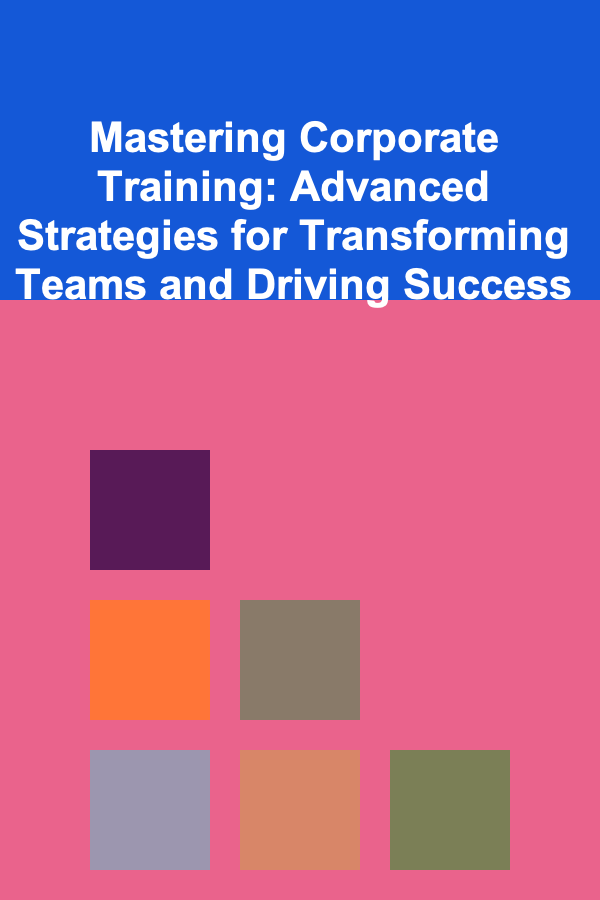
Mastering Corporate Training: Advanced Strategies for Transforming Teams and Driving Success
ebook include PDF & Audio bundle (Micro Guide)
$12.99$5.99
Limited Time Offer! Order within the next:

Corporate training is no longer just a box to check on a company's to-do list. It's an integral part of shaping successful teams and driving business growth. In an ever-evolving business landscape, organizations must continually adapt to new technologies, market trends, and leadership styles. The key to staying competitive lies in how effectively teams are trained and developed. In this actionable guide, we explore advanced strategies for mastering corporate training to enhance team performance, boost morale, and drive organizational success.
Understanding the Evolution of Corporate Training
Corporate training has come a long way from the days of one-size-fits-all, in-person workshops. Today, corporate training is more personalized, data-driven, and aligned with specific business goals. Successful training programs are not just about transferring knowledge---they are about empowering employees to apply what they learn to real-world scenarios and organizational challenges.
Modern corporate training requires a strategic approach that:
- Recognizes the diverse learning styles and needs of employees.
- Aligns with business objectives and the company's vision.
- Utilizes technology to deliver training in more engaging and efficient ways.
- Focuses on continuous learning and development rather than isolated events.
With these considerations in mind, let's dive into advanced strategies that will elevate your corporate training programs.
Strategy #1: Align Training with Organizational Goals
One of the most significant mistakes organizations make is treating training as a one-off event or an afterthought. Training should always be tied to the broader business goals and the skills required to achieve them. Without this alignment, even the best training programs can fall short in terms of driving organizational success.
How to Align Training with Organizational Goals:
- Assess Business Needs: Identify the core skills required for achieving the company's objectives. This can involve understanding upcoming projects, the direction of the industry, and the competencies needed for growth.
- Collaborate with Leaders: Work with department heads, managers, and executives to ensure the training program addresses the specific needs of their teams. Tailor the program to address not just broad organizational goals but also individual team goals.
- Set Measurable Outcomes: Define clear, measurable outcomes that are directly tied to the organization's success. For instance, if the goal is to improve customer service, the training program should focus on communication skills, conflict resolution, and empathy, with measurable KPIs such as customer satisfaction scores.
By aligning training with strategic business goals, you ensure that the skills employees acquire will have a direct and tangible impact on company performance.
Strategy #2: Foster a Continuous Learning Culture
Gone are the days when a single training session would suffice for employees to be equipped with the necessary skills. With constant changes in technology, markets, and best practices, fostering a continuous learning culture is crucial for sustained success.
How to Foster a Continuous Learning Culture:
- Promote Lifelong Learning: Encourage employees to take ownership of their professional development. Provide access to learning resources like e-learning platforms, webinars, and conferences. Empower employees to pursue certifications and qualifications relevant to their roles.
- Implement Microlearning: Microlearning involves delivering content in small, digestible chunks. This method makes it easier for employees to fit learning into their busy schedules and ensures better retention. Microlearning can include short video tutorials, quick quizzes, and infographics that cover specific skills or concepts.
- Create Knowledge Sharing Platforms: Use internal platforms like forums or collaborative tools (e.g., Slack, Microsoft Teams) to facilitate knowledge sharing. Allow employees to exchange insights and tips based on their experiences, creating a culture of peer-to-peer learning.
- Encourage Feedback and Reflection: Develop a system for employees to reflect on what they've learned and share feedback. Regular reflection helps reinforce learning and highlights areas for further improvement.
By embedding learning into the fabric of the workplace, you ensure that employees continue to grow and adapt to ever-changing demands.
Strategy #3: Use Technology to Enhance Training Effectiveness
Technology plays a pivotal role in modernizing corporate training programs. Leveraging digital tools not only enhances the learning experience but also makes training more efficient and scalable.
How to Use Technology to Enhance Training:
- Learning Management Systems (LMS): LMS platforms such as Moodle, TalentLMS, or Docebo offer an easy way to deliver, track, and manage employee training. These platforms allow organizations to create personalized learning paths, track progress, and measure the effectiveness of training programs.
- Virtual Reality (VR) and Augmented Reality (AR): VR and AR offer immersive training experiences that can simulate real-world scenarios. This is especially useful in high-risk industries like healthcare or manufacturing, where hands-on training is necessary but may not always be feasible.
- Gamification: Gamifying training programs can boost engagement and motivation. Incorporating elements like point systems, leaderboards, and rewards turns learning into a more interactive and fun experience.
- AI-Powered Personalized Learning: Artificial intelligence can analyze employee performance and recommend personalized learning paths. These intelligent systems help tailor the training experience to an individual's strengths, weaknesses, and career aspirations.
By leveraging the power of technology, you can make training more interactive, personalized, and accessible, creating a more engaging experience for employees.
Strategy #4: Focus on Soft Skills Development
While technical skills are essential, soft skills often make the difference between a good employee and a great one. Soft skills such as communication, problem-solving, adaptability, and emotional intelligence are crucial for collaboration, leadership, and customer interactions.
How to Focus on Soft Skills Development:
- Leadership Training: Invest in leadership development programs that help emerging leaders build skills in decision-making, conflict resolution, and team management. Great leaders inspire and guide teams toward achieving organizational success.
- Emotional Intelligence: Training in emotional intelligence helps employees better understand and manage their emotions and the emotions of others. This is essential for improving interpersonal relationships, fostering collaboration, and handling conflict.
- Communication Skills: Training employees to communicate effectively, whether through writing or speaking, is crucial. Clear communication promotes productivity, reduces misunderstandings, and improves teamwork.
- Problem-Solving and Critical Thinking: Encourage employees to think critically about problems and develop solutions. This can be achieved through case studies, brainstorming sessions, or scenario-based learning, where employees are given complex problems to solve as a group.
By focusing on soft skills, you equip employees to handle interpersonal dynamics, manage challenges, and contribute positively to the organizational culture.
Strategy #5: Measure Training Effectiveness and Adapt
One of the most important aspects of corporate training is measuring its effectiveness. Without metrics, it's impossible to know whether the training has had a positive impact on the business. This is where data-driven approaches come into play.
How to Measure and Adapt Training Programs:
- Set Key Performance Indicators (KPIs): Identify specific KPIs that will help you measure the success of your training programs. These could include productivity metrics, employee engagement scores, retention rates, and post-training performance assessments.
- Surveys and Feedback: Use surveys, focus groups, and interviews to gather feedback from employees about the training experience. Ask questions about the relevance of the content, the delivery method, and the practical application of the skills learned.
- Track Long-Term Impact: While short-term metrics like quiz scores are useful, it's important to track the long-term impact of training on employee performance and business outcomes. This can include assessing employee promotion rates, sales growth, or customer satisfaction improvements.
- Adapt and Improve: Use the insights gathered from feedback and performance metrics to refine and adapt your training programs. Continuous evaluation ensures that the training remains relevant, impactful, and aligned with the company's evolving needs.
By measuring the effectiveness of your training programs and adapting them over time, you ensure that your investment in training continues to pay off in tangible results.
Conclusion: Transforming Teams for Success
Mastering corporate training is a dynamic process that requires strategic planning, continuous improvement, and a deep understanding of the organization's goals. By aligning training with business objectives, fostering a culture of continuous learning, leveraging technology, focusing on soft skills, and measuring success, you can create training programs that transform your teams and drive organizational success.
Investing in employee development is not just about skill acquisition---it's about building a resilient and adaptable workforce capable of navigating the complexities of today's business world. When executed properly, corporate training becomes a powerful tool for driving growth, fostering innovation, and achieving long-term success.
Reading More From Our Other Websites
- [Organization Tip 101] How to Use Time Blocks for Efficient Home Organization
- [Personal Care Tips 101] How to Choose a Body Lotion with SPF Protection
- [Personal Care Tips 101] How to Deal with Common Men's Grooming Problems: A Personal Care Troubleshooting Guide
- [Ziplining Tip 101] From Cable Cars to Zip Lines: How Cities Are Turning Skyscrapers into Playgrounds
- [Survival Kit 101] How to Build a Survival Kit for Kids with Asthma: What to Include
- [Trail Running Tip 101] Training Plans Compared: Building Endurance on Trails vs. Pavement
- [Organization Tip 101] How to Organize Your Hot Glue Gun and Accessories
- [Sewing Tip 101] Serger vs. Regular Sewing Machine: When to Choose Each Tool
- [Home Renovating 101] How to Incorporate Smart Home Technology into Your Renovation
- [Organization Tip 101] The Benefits of Installing a Low-Flow Toilet in Your Home

How to Clean Your Home After a Renovation or Construction Project
Read More
How to Plan a Sustainable Renovation for Your Home
Read More
How to Use Magnetic Strips for Tool Organization
Read More
Smart Strategies for Saving Money on Wedding Photography and Videography
Read More
How to Transition from Manual to Automation Testing
Read More
How to Build a Sales Planner for Freelancers
Read MoreOther Products

How to Clean Your Home After a Renovation or Construction Project
Read More
How to Plan a Sustainable Renovation for Your Home
Read More
How to Use Magnetic Strips for Tool Organization
Read More
Smart Strategies for Saving Money on Wedding Photography and Videography
Read More
How to Transition from Manual to Automation Testing
Read More